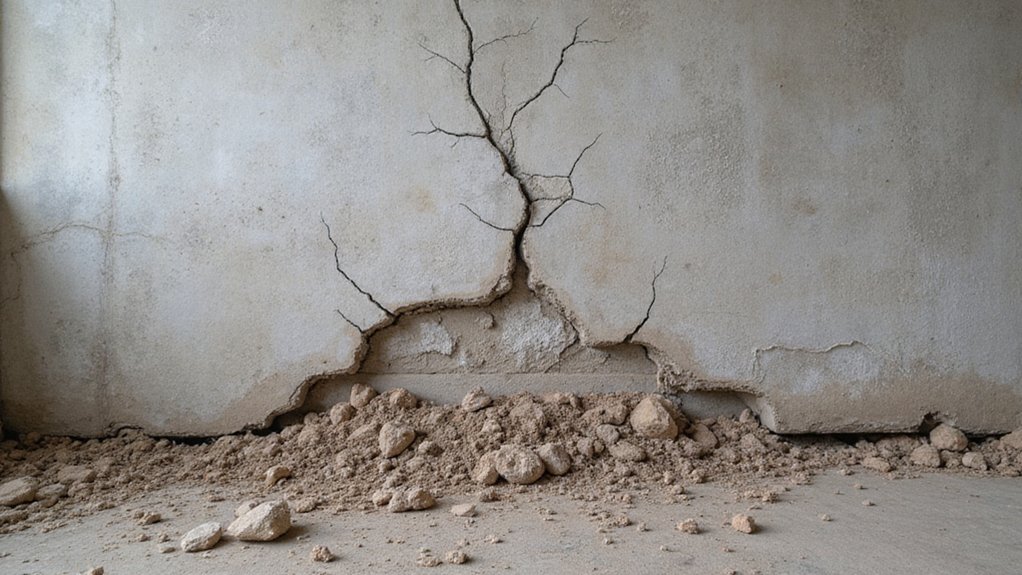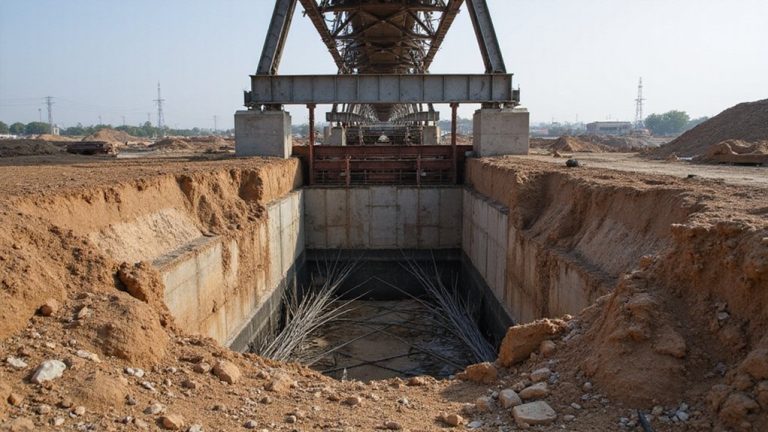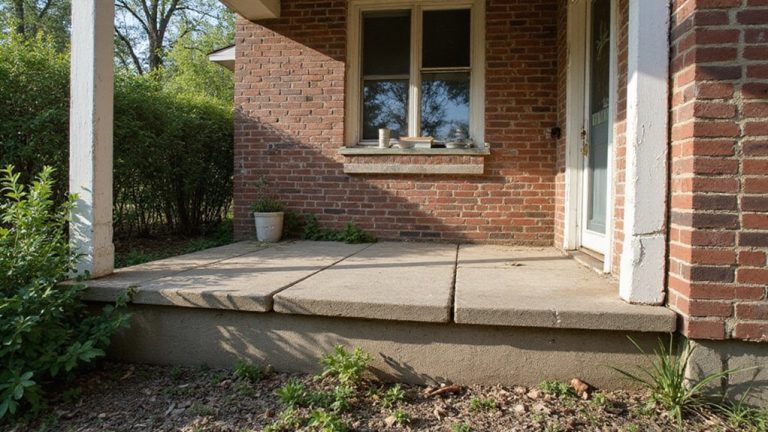Your basement walls shouldn’t be bowing – that’s a surefire sign of serious structural issues you can’t afford to ignore. Bowing walls indicate underlying problems like soil erosion or hydrostatic pressure that can compromise your home’s stability. Leaving these problems unresolved puts your family’s safety at risk and leads to costly, complex repairs down the line. While it may be tempting to overlook the problem, tackling it now is indispensable to maintain your home’s structural integrity and prevent potential collapse. The causes and solutions might not be obvious, but addressing bowing walls is paramount to protecting your investment and your loved ones.
The Dangers of Bowing Walls
If your basement walls are bowing, it’s important to understand the dangers involved. Bowing walls can be a sign of soil erosion or shifting soil patterns, often caused by wet weather. As the soil moves, it applies pressure to your basement walls, causing them to bow inward. This structural damage weakens the integrity of your home, leading to potential collapse if left unchecked. Horizontal foundation cracks can indicate severe structural stress that may require immediate professional intervention. Ignoring bowing walls puts your family’s safety at risk and can result in costly repairs down the line. Addressing this issue urgently is essential to maintaining a secure and stable foundation for your home.
Identifying the Causes of Bowing Walls
There are several potential causes for bowing basement walls that you’ll want to investigate. Some common culprits include:
- Soil moisture levels: Fluctuations in the water table or excessive rainfall can saturate the soil surrounding your foundation, causing it to swell and push inward on your basement walls.
- Hydrostatic pressure: When the groundwater level rises, it creates an imbalance of pressure that can literally push your walls inward over time.
- Poor drainage: Clogged or malfunctioning drainage systems allow water to accumulate around your home’s foundation, leading to wall bowing.
Stabilizing braces and anchors can help mitigate these issues and prevent further structural damage to your basement walls.
The Impact of Bowing Walls on Your Home’s Structure
Bowing basement walls can have a significant impact on your home’s structural integrity. These concerning issues can lead to moisture infiltration risks, compromising the stability of your foundation.
When the walls start to bend inward, it’s a clear sign of underlying problems that require prompt attention. Neglecting bowing walls can result in costly repairs down the line, as the structural problems can worsen over time.
Addressing these concerns proactively is essential to maintaining the safety and longevity of your home. Don’t wait until the problem escalates – be vigilant and address bowing walls without delay.
The Risks of Leaving Bowing Walls Unaddressed
Why let bowing walls linger and risk exacerbating the problem? Ignoring these structural integrity issues can lead to:
- Foundation stability concerns, as the shifting walls compromise the home’s structural foundation.
- Potential collapse or catastrophic failure, putting your family’s safety at risk.
- Significant repairs that become increasingly complex and costly the longer you wait.
Addressing bowing basement walls imperative to maintaining the safety and value of your home. Don’t delay – take action to resolve these foundation stability concerns before they escalate.
Early Signs of Bowing Walls You Shouldn’t Ignore
Although it may be tempting to dismiss minor cracks or bulges in your basement walls, these seemingly innocuous signs can actually be early indicators of a more serious structural issue.
Foundation settling or soil erosion can cause your walls to gradually bow inward, resulting in cracks and bulges. Don’t ignore these warning signs – they could signify a weakening foundation that requires prompt attention.
Addressing bowing walls early on can prevent further damage and costly repairs down the line. Stay vigilant and address any wall irregularities right away to protect the integrity of your home.
Methods for Repairing Bowing Basement Walls
Several effective methods are available to repair bowing basement walls and restore the structural integrity of your home. Consider these options:
– Wall reinforcement solutions, such as carbon fiber straps or steel I-beams, can stabilize and straighten bowing walls.
Basement waterproofing techniques, like drainage systems and sealants, can address the underlying moisture issues that contribute to wall bowing.
Hydraulic wall anchors, driven into the ground outside your home, can pull inward-leaning walls back into their proper position.
These methods can help you reclaim your basement’s structural soundness and prevent further damage to your home.
Preventing Future Bowing Wall Issues
Now that you’ve addressed the current methods for repairing bowing basement walls, it’s important to ponder how you can prevent such issues from occurring in the future. Proper grading techniques around your home’s foundation are vital to directing water away from the basement.
Additionally, investing in effective waterproofing solutions like sealants, drainage systems, and exterior water management can go a long way in safeguarding your home. By taking proactive steps to address the root causes, you’ll avoid the headache and expense of future bowing wall problems, giving you peace of mind in your home.
When to Seek Professional Help for Bowing Walls
When is it time to seek professional help for bowing walls in your basement? Consider the following:
Walls that have bowed more than 1 inch inward or show signs of cracking, buckling, or bulging – these indicate a structural issue that requires immediate attention.
Periodic wall inspections to monitor any changes or worsening of the bowing. Catching it early is key to addressing the root causes.
If you notice water seepage, dampness, or condensation along the bowing walls, as this can signify underlying moisture problems that need professional diagnosis and remediation.
Frequently Asked Questions
Can Bowing Walls Be Fixed Without Professional Help?
While DIY repair methods may seem tempting, bowing walls require a professional inspection to guarantee proper and safe structural reinforcement. Attempting to fix this issue yourself could lead to further damage and compromise your home’s stability.
Do Bowing Walls Always Indicate a Structural Issue?
Bowing walls don’t always indicate structural issues. However, they could signal soil erosion concerns or water drainage problems that shouldn’t be ignored. Addressing these issues promptly can help protect your home and provide a greater sense of security.
How Much Does It Cost to Repair Bowing Walls?
Repairing bowing walls can cost $3,000 to $10,000. Compare quotes from contractors and negotiate the best price. Addressing this issue promptly prevents further damage and protects your home’s value.
How Long Does It Take to Fix Bowing Walls?
Addressing bowing walls typically takes 2-4 weeks, depending on the underlying causes of bowing. The average timeline for repairs involves addressing structural issues to restore your home’s safety and stability.
Can Bowing Walls Be Prevented During Construction?
You can prevent bowing walls during construction by ensuring proper soil compaction and effective waterproofing. This’ll protect your home’s foundation, saving you from costly repairs down the line and giving you peace of mind.



